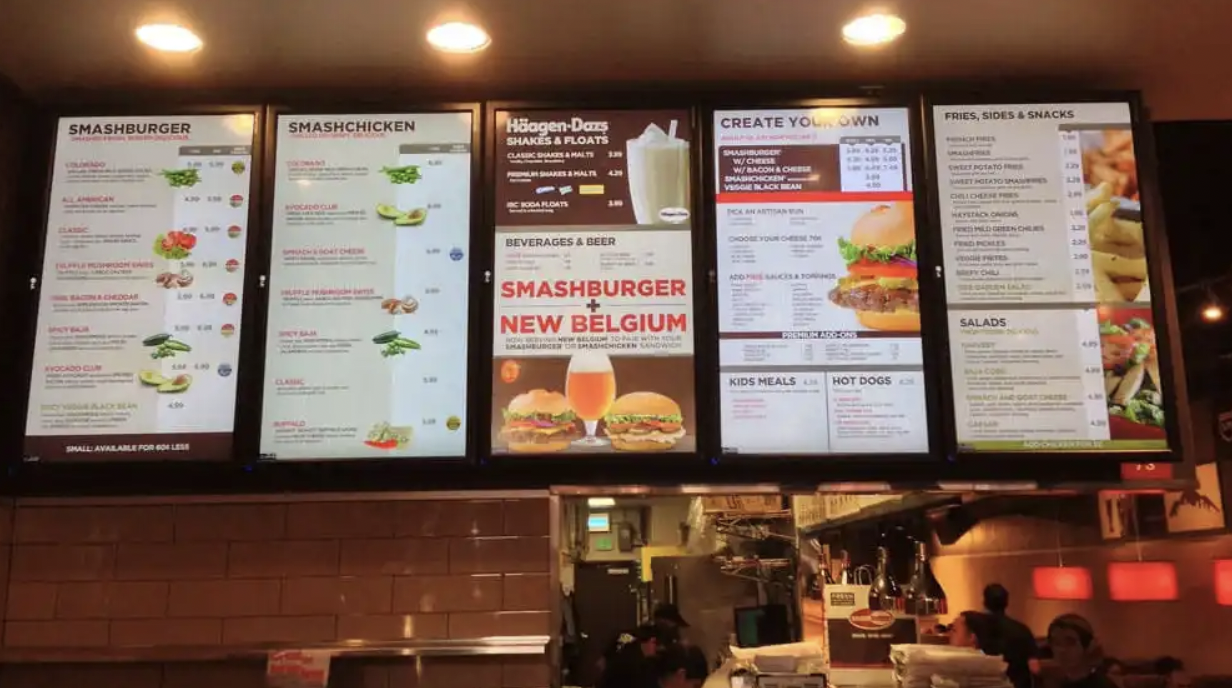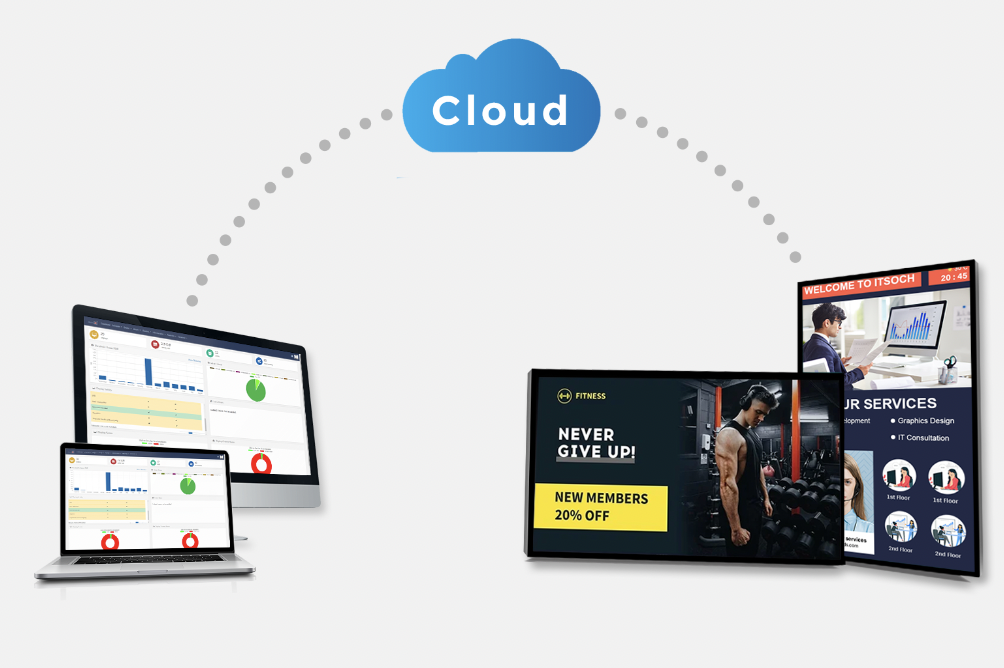Digital signage is increasingly recognized as a powerful tool in marketing, leveraging well-designed visual content to convert casual browsers into dedicated customers and effectively convey business messages through various mediums, including promotional videos, digital menu boards, and infographics.
This article explores the role of digital signage in enhancing customer acquisition within the broader context of visual communication, encouraging businesses to tap into its potential for greater success.
Click on each corresponding link to jump ahead:
- Visual Communication vs Other Communication Methods
- Introducing Digital Signage
- The Role of Digital Signage in Customer Acquisition
- Various Forms of Digital Signage
- Designing Effective Digital Signage For Customer Acquisition
- Adapting to the Current Digital Signage Trends
- Implementing Digital Signage in Your Business Setting
- Case Studies That Demonstrate the Power of Digital Signage
- Insights into Action: Applying Digital Signage Data in Business
- FAQs
If you have any questions concerning how to enhance customer acquisition through digital signage, contact us!
Key Takeaways
| 1. Visual communication, being highly engaging and influential, is a potent tool in modern marketing strategies. |
| 2. Digital signage plays a pivotal role in transforming casual viewers into dedicated customers. |
| 3. Embracing the diversity of digital signage, from indoor signs to digital menu boards, can cater to specific audience needs and marketing objectives. |
| 4. Effective design, focused on audience understanding and compelling content, is key to the success of digital signage. |
| 5. Strategic implementation involves careful planning, technological understanding, and consistent monitoring of digital signage performance. |
| 6. Latest Trends and case studies give real-life insights into the power of digital signage, and serve as a source of inspiration and learning. |
| 7. Data insights, when applied, can help refine digital signage strategies and enhance results. |
1. Visual Communication vs Other Communication Methods
Visual communication employs images, colours, symbols, and even videos to convey a message or a story. As a profoundly impactful way of expression, it can engage viewers, influence their emotions, and guide their actions.
With the human brain processing visuals 60,000 times faster than text, it's no wonder visual communication has become a non-negotiable tool in today's marketing landscape.
When it comes to digital marketing and improving customer acquisition, digital signage holds a distinct advantage due to its ability to engage audiences effectively. Here's how the power of visual communication through digital signage can enhance customer acquisition in the context of digital marketing:
- Capturing Attention: In the digital realm, grabbing the audience's attention is a constant challenge. Digital signage, with its dynamic and eye-catching visuals, can quickly capture the attention of passersby, website visitors, or social media users. This initial engagement is crucial for customer acquisition as it prompts potential customers to explore further.
- Visual Storytelling: Digital signage allows businesses to tell compelling visual stories. Through videos, animations, and graphics, you can convey your brand's narrative, product benefits, or customer success stories in an engaging manner. Storytelling enhances brand recall and encourages potential customers to connect with your brand emotionally.
- Location-Based Targeting: Digital signage can be strategically placed in physical locations or on websites and social media platforms frequented by your target audience. This targeted approach ensures that your visual content reaches those most likely to become customers, increasing the chances of acquisition.
- Interactive Experiences: Interactive digital signage, such as touch screens or QR code integration, encourages audience engagement. It allows customers to explore your products or services in-depth, request more information, or even make immediate purchases. Interactive elements can lead to higher conversion rates and customer acquisition.
- Real-Time Updates: Digital signage can display real-time information, promotions, or offers. This agility allows businesses to adapt quickly to changing market conditions and customer preferences, keeping their acquisition strategies current and relevant.
- Data-Driven Insights: Digital signage platforms often provide data analytics, allowing you to track the performance of your visual content. By analyzing metrics such as viewer engagement, conversion rates, and click-through rates, you can refine your digital marketing strategies for better customer acquisition results.
- Consistent Branding: Digital signage ensures a consistent brand image across different channels, reinforcing your brand identity and values. Consistency builds trust, making it more likely that potential customers will choose your brand over competitors.
- Multi-Channel Integration: Integrating digital signage with other digital marketing channels, such as social media and email campaigns, creates a cohesive marketing strategy. This synergy reinforces your brand message and can lead to increased customer acquisition through cross-channel promotion.
In summary, digital signage's power in visual communication is a valuable asset in the digital marketing landscape. Its ability to capture attention, tell engaging stories, target specific audiences, and provide real-time data insights can significantly enhance customer acquisition efforts. By leveraging the strengths of digital signage, businesses can create a memorable and effective customer acquisition strategy in the digital age.
2. Introducing Digital Signage

Digital signage refers to a versatile and dynamic communication tool that utilizes various digital displays, including LED screens, video walls, touch screens, and interactive kiosks, to present multimedia content in a visually compelling manner.
These digital displays are strategically placed in a wide range of environments, from retail stores, restaurants, and hotels to transportation hubs, corporate offices, and public spaces.
The primary objective of digital signage is to captivate and engage audiences by showcasing targeted, real-time, and interactive content, making it a vital component of modern marketing and communication strategies.
Digital signage serves multiple purposes across diverse industries. In retail, it can highlight promotions, showcase product features, and create immersive shopping experiences. In the hospitality sector, it enhances guest experiences by providing information about amenities, services, and local attractions. At airports, digital signage delivers real-time flight information, wayfinding assistance, and advertising opportunities. In corporate buildings, it facilitates internal communication by displaying company news, updates, and event schedules.
One of the key advantages of digital signage is its adaptability. Content can be easily updated and customized to suit specific audiences or contexts, allowing businesses to remain flexible and responsive to changing needs. Moreover, the interactive capabilities of some digital signage, such as touch screens and QR code integration, enable users to actively engage with the displayed content, whether it's browsing product catalogs, accessing additional information, or making on-the-spot purchases.
By leveraging digital signage, businesses can significantly enhance their visibility, brand recognition, and customer engagement. Whether it's conveying information, promoting products, or creating memorable brand experiences, digital signage plays a pivotal role in modern communication strategies, enabling businesses to connect with their target audiences in a visually captivating and impactful way.
3. The Role of Digital Signage in Customer Acquisition
Digital signage plays a pivotal role in influencing every stage of a customer's buying journey. As prospective customers encounter strategically placed digital displays featuring custom-tailored content, their attention is immediately captured. These displays serve as powerful magnets, drawing individuals into the business's sphere of influence. Here, they are presented with dynamic, visually engaging content that not only informs but also entices and persuades.
When it comes to customer acquisition, digital signage also plays an immense role in:
- Attracting Attention and Engagement: Digital signage excels at grabbing the attention of passersby, whether they are in a physical store or visiting a website. High-quality graphics, compelling videos, and interactive elements create a sensory experience that encourages further exploration. Potential customers are more likely to linger, browse, and interact with the content, fostering a sense of curiosity and interest.
- Providing Information and Persuasion: Beyond mere attention-grabbing, digital signage serves as an informative and persuasive tool. It can showcase product features, benefits, and pricing, helping customers make informed decisions. Real-time updates can highlight current promotions, discounts, or limited-time offers, motivating potential buyers to act swiftly. Moreover, digital signage can demonstrate product applications and success stories, addressing customer pain points and building trust
- Enhancing Brand Recall: Effective digital signage contributes significantly to brand recall. The captivating visuals and messaging leave a lasting impression on viewers. This means that even if a customer doesn't make an immediate purchase, they are more likely to remember the brand and its offerings. This heightened brand recall can lead to future purchases or recommendations to friends and family.
- Personalization and Targeting: Digital signage can be personalized and tailored to specific demographics or customer segments. Using data analytics and user preferences, businesses can display content that resonates with a particular audience. This level of personalization increases the chances of acquiring customers who are more likely to engage with and buy from the brand.
- Measurable Impact: One of the advantages of digital signage in customer acquisition is its trackability. Businesses can measure the effectiveness of their signage campaigns through metrics such as engagement rates, click-through rates, and conversion rates. This data-driven approach enables continuous optimization of content and strategies for better results.
In conclusion, digital signage is not just a passive display; it is a dynamic tool that actively engages potential customers, guides them through the decision-making process, and enhances brand recall. By creating immersive and persuasive experiences, digital signage significantly contributes to customer acquisition efforts, ultimately leading to increased sales and business growth.
4. Various Forms of Digital Signage
Digital signage offers businesses a wide range of options when it comes to advertising and engaging with audiences. Its versatility is evident in the different forms it can take.
Let's take a closer look at some of the popular types of digital signage:
a) Indoor and Outdoor Digital Signs

Indoor digital signs are commonly used in spaces like:
- Shopping malls
- Airports
- Restaurants
- Corporate offices
They can be used to display promotional content, event information, welcome messages, or even interactive wayfinding systems.
Outdoor digital signs, on the other hand, are typically larger and more robust to withstand different weather conditions. They are often found in places like:
- Highways
- City centres
- Sports stadiums
They are especially good at capturing the attention of pedestrians and motorists.
b) Digital Menu Boards

Digital menu boards have revolutionized the way restaurants and cafes display their menus. Instead of paper menus, digital screens are used to showcase the variety of food and drinks available.
These dynamic displays allow for easy updates and can feature eye-catching visuals to entice customers. With the ability to showcase special offers, promotions, and allergen information in real-time, digital menu boards provide a more engaging and informative dining experience.
c) Digital Billboards

Digital billboards are large display screens often found alongside highways or in busy urban areas. These attention-grabbing displays offer advertisers a unique opportunity to reach a wide audience.
Unlike traditional billboards, digital billboards can display multiple ads in a rotation, creating more exposure for different businesses. Timely updates and the ability to display dynamic content make digital billboards a versatile and impactful advertising tool.
d) Interactive Kiosks

Interactive kiosks are self-service stations that allow customers to access information or perform transactions. Their interactive nature enables businesses to provide a personalized and convenient experience.
For example, in retail environments, customers can use interactive kiosks to:
- Browse products
- Check stock availability
- Place orders.
In public spaces like museums or airports, interactive kiosks can provide visitors with:
- Maps
- Information on exhibits
- Ticket purchasing options
These forms of digital signage continue to grow in popularity and for good reason.
5. Designing Effective Digital Signage For Customer Acquisition
There are several factors that determining whether or not your digital signage design is effective or not, such as:
- Understanding your target audience
- Setting clear objectives
- Crafting compelling content
The aim should be to present information in an attractive and digestible manner that not only grabs attention but leaves a lasting impression on the customer's mind. One way to stand out among the rest is to utilize the power of personalization in digital signage.
a) The Power of Personalization in Digital Signage
Personalization in digital signage involves the customization of content to cater to a specific audience, with the goal of:
- Capturing attention
- Enhancing the customer experience
- Driving sales and conversions
Personalized digital signage can create an intimate connection with customers. It shows that you understand and value them, thereby fostering deeper engagement and loyalty.
Here are three classic examples of effective personalized digital signage:
- Retail Stores: Digital signage in a clothing store can display targeted promotions based on customers' past purchases or browsing history. For instance, a customer who has previously bought athletic wear could see promotions for new sports gear, thereby enhancing their shopping experience and increasing the chances of a repeat purchase.
- Restaurants: Digital Menu Boards in restaurants can adapt to different times of the day. A cafe could display breakfast options in the morning, moving on to lunch deals in the afternoon, and switching to dessert specials in the evening. This system provides a personalized customer experience, encouraging them to make a purchase that fits their current cravings and needs.
- Banks: ATMs with digital screens can use personalized messaging to provide individualized financial product suggestions. Based on a customer's past transactions and account behaviour, the ATM screen could suggest relevant finance products like specific saving accounts, loans, or credit cards. This not only adds value to the customer's banking experience but also drives sales for the bank.
Whatever method you choose to employ, to ultimately increase customer acquisition, make sure it is unique and personalized.
6. Adapting to the Current Digital Signage Trends
Businesses are witnessing a seismic shift in digital signage, transitioning from a primarily hardware-centric approach to an expansive landscape where the power of the cloud reigns supreme.
Moreover, the advent of software integrations is revolutionizing how businesses manage and utilize their digital signage, offering more streamlined operations and efficient controls.
Keeping up with these trends in cloud-based solutions and software integrations can significantly enhance your marketing efforts, driving a profound impact on your conversion and sales outcomes.
a) The Answer Lies in the Cloud

The current digital landscape demands flexibility and adaptability. The spotlight is firmly on powerful concepts like interconnectivity and interactivity, which have proven their worth in turbulent times such as the COVID-19 pandemic. If we have learned anything at all from these difficult times it is that businesses need to learn to adapt and find new methods of content delivery for sustained success.
Cloud-based digital signage solutions act as a game-changer for businesses grappling with hardware challenges. Empowered by the expanding capabilities of cloud-based technology, businesses are finding a lifeline for their digital signage needs.
Cloud-based systems, with their computing power and data storage capabilities, offer unprecedented convenience and control. They allow businesses to:
- Manage and modify their digital signage content remotely
- Adapt swiftly to market trends
- Cater to their audience's demands in real-time
In return, this saves businesses both time and resources.
Moreover, the cloud also empowers digital signage with greater interactivity, providing businesses the opportunity to engage their customers better and foster deeper relationships. Interactive digital signage experiences, whether in a retail store or a food outlet, can propel customer engagement, boosting sales and conversion rates.
b) Software Integrations: The Future of Efficient Digital Signage Management
Software integration enables businesses to:
- Streamline their operations
- Increase efficiency
- Provide a seamless user experience
Consider Look software integrations.
As an example, consider LOOK software integrations, which has mastered the art of integrating various digital solutions under one roof. With this software, businesses can extend their capability to manage not only their digital signage but also scheduling, interactive content, and multi-screen synchronization, all from a single dashboard.
The integration of varied software solutions like this is pushing the boundaries of what digital signage can achieve, carving a more interactive, efficient, and customer-centric path for businesses to follow.
7. Implementing Digital Signage in Your Business Setting
The process of implementing digital signage may seem daunting initially, but with a strategic approach, you can effectively incorporate this powerful tool into your business operations.
Here are some key steps and factors to consider:
- Identifying Your Needs: The first step is to define the primary goal of your digital signage. It could be anything from promoting a new product line to improving customer engagement or enhancing in-store ambiance.
- Choosing the Right Location: The placement of your signage and the viewing distance greatly influences its effectiveness. High-visibility areas such as entry points, waiting areas, or high foot-traffic zones are ideal.
- Selecting Suitable Hardware or Software: Depending on your needs, you can choose from various types of displays (like LCD, LED, projection screens), digital media players, or even interactive touch screens. The quality, durability, and functionality of hardware are crucial to effective digital signage. Integration with cloud-based solutions and software also allows for remote content management and seamless integration with other systems, enhancing the overall functionality and impact of digital signage.
- Designing Engaging Content: The content displayed should be dynamic, engaging, and relevant. Coupling alluring visuals with concise and captivating text can ensure maximum impact.
- Content Management System (CMS): An effective CMS allows easy management of the content displayed on your signs. It should provide features such as scheduling, real-time updates, and content modification.
- Installation: It's important to ensure proper installation to avoid technical glitches. Depending upon the complexity, you might require professional installation services.
- Monitor Performance: To measure your digital signage's success, monitoring analytics such as viewer engagement, the increase in sales, or customer feedback is essential. Based on the insights, content or placements can be optimized for improved results.
Remember, the implementation of digital signage is not a one-time affair: it's an ongoing process that requires regular assessment, tweaking, and updating.
As your customer's needs and preferences change, so too should your digital signage approach. The more adaptable and responsive you are, the higher the success you'll achieve with your digital signage campaign.
8. Case Studies That Demonstrate the Power of Digital Signage
The effectiveness of digital signage can best be seen in its successful application across numerous businesses. Below are four notable case studies that showcase the power and potential of digital signage to drive sales and customer engagement.
a) McDonald's Jumps on the Digital Signage Bandwagon
The fast-food giant embraced digital signage by introducing digital self-order kiosks and menu boards in their outlets worldwide. This move not only enhanced the customer ordering experience but also significantly boosted sales, with consumers reported to spend more when using these kiosks.
b) A Triumph for Prime Burger
Prime Burger, a London-based chain, experienced a tremendous sales increase by 50% after investing in digital signage screens for their menu boards. The inclusion of high-quality images and animations proved incredibly engaging for customers, underscoring the magnetism of visually appealing content.
c) Uplifting Sales at Lift
Lift, a modern cannabis dispensary in Toronto, leveraged digital signage to create compelling product showcases and sales promotions on high-definition screens in their store. The result was a substantial increase in repeat customers and higher revenue generation.
d) Sport Chek's Technological Leap
Sport Chek, Canada's largest sports equipment retailer, reinvented its customer shopping experience by integrating digital signage across its retail outlets. The digitized product information, compelling visuals, and interactive content led to a significant increase in customer dwell time and, ultimately, sales.
These successful implementations of digital signage emphasize its power as an engaging communication tool with the capacity to encourage increased customer dwell time and drive sales.
Businesses across the globe continue to recognize and adopt this practical and impactful advertising technique to revamp their marketing strategy.
9. Insights into Action: Applying Digital Signage Data in Business
Understanding the impact of digital signage on consumer behaviour can provide invaluable insights into devising effective strategies for your business.
Here's how you can apply some key statistics to boost your business performance:
- Attracting Foot Traffic with Digital Signage: Studies show that as much as 80% of consumers are influenced to enter a store after viewing its digital signage. Businesses can leverage this by strategically placing enticing digital displays in windows or outside their establishments to catch the attention of passersby and coax them inside.
- Driving Impulse Purchases: It's been noted that nearly one in five consumers have made spontaneous buys triggered by digital ads. To harness this, businesses can use digital signage to showcase limited-time offers, exclusive deals, or hot selling items, provoking impulse buying behavior among customers.
- Outshining Online Ads: According to an OAAA study, 71% of consumers find digital signage more memorable compared to online ads. This indicates the need for businesses to invest in eye-catching digital signage, utilizing engaging visuals and compelling messages to make a lasting impression, thus enhancing brand recall.
- Entertaining Guests in the Hospitality Industry: With a whopping 70% of hotel guests finding digital signage entertaining, hotels and resorts should not miss out on this opportunity. They can use digital screens to provide guests with useful information, fun facts, or local sightseeing options, making their stay more enjoyable and engaging.
- Increasing Views and Recall with Visuals: Digital signage is seen to outperform static displays by a staggering 400% in terms of generating views, proving its capacity to grasp attention. Further, incorporating visual aids in your digital signage can significantly magnify customer recall compared to standard digital displays. From this, it's clear that businesses should focus on creative, dynamic, and visually rich content in their digital signage to grab attention and improve brand retention.
- Digital Signage Market Growth: The Business Research Company highlighted the significant growth of the digital signage market, with a rise from $19.52 billion in 2022 to $21.59 billion in 2023. This statistic emphasizes the escalating importance of digital signage and its acceptance by businesses. Hence, businesses lagging in deploying digital signage should acknowledge its increasing relevance and consider reorienting their marketing strategies towards this powerful tool.
By translating these insights into actions, businesses can step up their digital signage strategies to attract, engage, and retain more customers, driving their sales growth and overall business success.
10. FAQs
Q: What Are Some Common Challenges Businesses Face When Implementing Digital Signage for Customer Acquisition?
When implementing digital signage for customer acquisition, businesses often face common challenges. These can include technical difficulties, lack of content strategy, and difficulty measuring ROI. It's important to address these obstacles to maximize the effectiveness of your digital signage.
Q: Are There Any Specific Industries or Sectors That Can Benefit the Most From Using Digital Signage for Customer Acquisition?
In using digital signage for customer acquisition, specific industries or sectors that benefit the most include retail, hospitality, healthcare, and transportation. These sectors can effectively engage and attract customers through dynamic and visually appealing content.
Q: How Can Businesses Measure the Effectiveness of Their Digital Signage in Terms of Customer Acquisition?
To measure the effectiveness of your digital signage in terms of customer acquisition, track metrics such as foot traffic, customer engagement, and conversion rates. Analyze the data regularly to identify areas for improvement and make informed decisions.
Q: Are There Any Legal Considerations or Regulations That Businesses Need to Be Aware of When Using Digital Signage for Customer Acquisition?
When using digital signage for customer acquisition, you need to be aware of legal considerations and regulations. Make sure you comply with privacy laws and obtain necessary permits or permissions for displaying content.
Q: Can You Provide Examples of Successful Customer Acquisition Campaigns That Have Utilized Digital Signage?
You can find successful customer acquisition campaigns that have utilized digital signage in various industries. These campaigns have effectively attracted new customers by leveraging the engaging and attention-grabbing nature of digital signage.
Final Thoughts
Embracing visual communication, and particularly, digital signage, has become an essential part of modern-day marketing strategies.
From understanding the power of visual communication to designing impactful digital signage and using data insights to refine strategies, the journey of unlocking the true potential of this digital medium is a continual learning process.
Stay flexible, stay informed, and continue to adapt your digital signage practices to ensure relevancy and success for your business.

